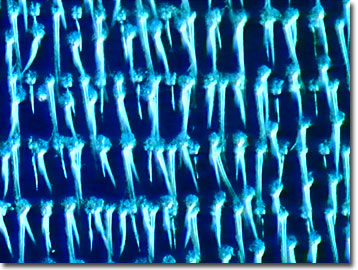Butterfly Wing Scale Digital Image Gallery
Tailed Jay Butterfly
The tailed jay, also known as the green spotted triangle butterfly, is an impressive tropical insect found throughout the Indo-Australian region. Adults feature large, beautiful green wings covered in black and white markings. Unfortunately for collectors, however, the species is not as vibrant in death as in life, the bright green color quickly fading into a dull yellow.

Tailed jay butterflies, classified as Graphium agamemnon by entomologists, are usually found near running water or moist ground on the edges of forests. Similar to other members of the swallowtail and birdwing butterfly family, the adult male tailed jay often drinks at puddles and spring seeps, gathering vital salts required for successful reproduction, as well as nutrients and moisture. Both sexes of tailed jays are very fast fliers and continue vibrating their wings rapidly even when they pause to nectar at flowers. When the butterflies are flying in open country, they are extremely difficult to catch.
Unlike many highly host-specific species, the tailed jay caterpillar is a generalist, feeding on the leaves of a wide variety of native and introduced plants in its habitat, including the custard apple, soursop, sugar apple and biriba. The rapacious caterpillars are colored dark green or brown and feature a white patch and a humped thorax. Each body segment of the caterpillar exhibits a pair of short black spines. When disturbed, tailed jay larvae rear up on their prolegs, briefly evert their brightly colored pair of osmeteria, and emit a strong smelling secretion in hopes of deterring predation. To some predators the swollen, rearing thorax with two false eyespots appears as a snake’s head and the osmeteria, its forked tongue.
The tailed jay is sold commercially worldwide to butterfly collectors and can be bred in captivity if sufficient supplies of suitable food plants, such as its favorite custard apple, can be secured. Over-collection of insular subspecies, rampant overpopulation, forest clearing, and pesticide use have all been detrimental to the welfare of this exotic tropical butterfly in its native habitat. However, the emergence of ecologically based tourism as a sustainable and profitable alternative to mining, forestry, grazing, and agriculture may help secure this emerald beauty's future.
Contributing Authors
Cynthia D. Kelly, Shannon H. Neaves, Laurence D. Zuckerman, and Michael W. Davidson - National High Magnetic Field Laboratory, 1800 East Paul Dirac Dr., The Florida State University, Tallahassee, Florida, 32310.
BACK TO THE BUTTERFLY WING SCALE IMAGE GALLERY
BACK TO THE DIGITAL IMAGE GALLERIES
Questions or comments? Send us an email.
© 1995-2025 by Michael W. Davidson and The Florida State University. All Rights Reserved. No images, graphics, software, scripts, or applets may be reproduced or used in any manner without permission from the copyright holders. Use of this website means you agree to all of the Legal Terms and Conditions set forth by the owners.
This website is maintained by our
Graphics & Web Programming Team
in collaboration with Optical Microscopy at the
National High Magnetic Field Laboratory.
Last Modification Friday, Nov 13, 2015 at 01:19 PM
Access Count Since January 21, 2003: 9016
Visit the website of our partner in introductory microscopy education:
|
|
